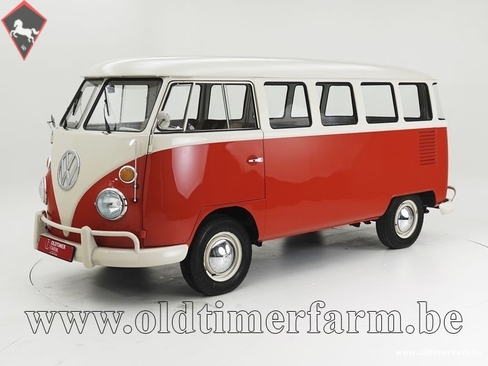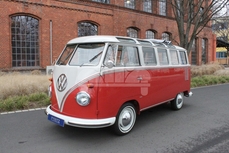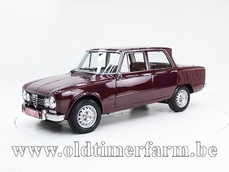Volkswagen T1 Minibus '74 1974
General description :
Imported to Belgium and completely restored Comes with official valuation documents After-production T1 that was manufactured in Brazil The Volkswagen Type 2 is Volkswagen’s workhorse in the form of a highly functional bus that is still omnipresent on the roads and adored by a very eclectic audience. Since 1950, it has been produced in six successive series, each bringing some modernization. In addition to its functionality, its design is pragmatic and contemporary, while older models evoke a nostalgic feeling. For a long period’s time, the Volkswagen range only had only had one model since its establishment: the Type 1 ‘Beetle’. In 1947, Dutch VW importer Ben Pon felt that the range should be expanded with a delivery van, he drew a sketch that was used three years later in the design of the Type 2, that was launched in 1950. It is a delivery van with the engine and design based on the Beetle. The engine is placed in the back, the round shapes are retained making its design look friendly. The Type 2 quickly developed its iconic status and beloved by everyone. The hippies were so enamoured that they went to live in the bus as if it were their home. They painted their campers as a protest against global famine, poverty, and war. The buses painted by hippies have become, along with the peace sign, the symbol of the hippie subculture and carefree 1960s. Over the years, many variants were sold. Initially, it was intended as a delivery van, but camping was soon made possible, and, in the US, people were particularly fond of the pickup variant. Volkswagen T1 The T1, an embodiment of nostalgia and the carefree 60s. This multifunctional ‘Splitscreen’ bus - as it is nicknamed based on the separate front twin-windshields - is the first car where the driver sits just above the front axle. The four-cylinder rear-engine produces just enough - modest - horsepower and a unique humming sound. Given the indestructible Volkswagen engine, an T1 is still very suitable for road tripping. They are also often used for commercial purposes, some even being converted into mobile coffee bars. It is undeniably true that the T1 is a highly coveted classic car, and the market demand is sky-high. Who wouldn't want to be seen in such a cool bus? Undoubtedly, a T1 is a versatile investment. Technical information: Body work Length (cm): 428 (169 inch) Width (cm): 172 (68 inch) Height (cm): 192 (76 inch) Wheelbase (cm): 240 (94 inch) Weight (kg): 1047 (2308 lbs) Mechanics Engine: 1493 cc four-cylinder rear-boxer engine Valve gear: 8 Fuel system: 1 Solex carburettor Gear box: 4-speed manual Transmission: RWD Left-steered power: 53 hp (39 kW) at 4200 t/m torque: 105 Nm at 2400 t/m Top speed: 105 km/h (65 mph)
1974 Volkswagen T1 Minibus '74 is listed for sale on ClassicDigest in Aalter by Oldtimerfarm for €36950.
Car Facts
Car type : Car Make : Volkswagen Model : T1 Model Version : Minibus '74 Engine size : 0.0 Model Year : 1974 Location : Aalter Vehicle Registration : Undefined
36950 €
People who viewed this Volkswagen T1 also viewed similar Volkswagen listed at ClassicDigest
Other cars listed for sale by this dealer
About Volkswagen
The Volkswagen story is indeed an intriguing tale of innovation, resilience, and post-war revival, marked by various models that have become iconic in automotive history.The People's Car (Volkswagen): Initially envisioned by Adolf Hitler in the 1930s as a "people's car" or "Volkswagen" in German, the idea was to create an affordable and practical vehicle for the German people. This concept led to the development of the Volkswagen Beetle (or the Type 1), designed by Ferdinand Porsche.
Post-War Challenges: After World War II, Volkswagen faced significant challenges. The factory was heavily damaged, and the brand's association with the Nazi regime led to a lack of interest in the car in some regions.
British Intervention - The British Army & Ivan Hirst: The British Army took control of the factory in the immediate post-war period. Major Ivan Hirst, a British Army officer, played a crucial role in reviving Volkswagen. He recognized the potential of the Beetle and advocated for its production, convincing the British military to order several thousand cars. This decision helped jumpstart the brand's revival.
Export Success and the Beetle's Global Appeal: The Beetle gained popularity not only in Germany but also globally, becoming an icon of affordable motoring. Its simple, reliable design and unique appearance made it a favorite among consumers worldwide.
Model Evolution: Over the years, Volkswagen introduced various models alongside the Beetle, each contributing to the brand's growth:
Type 2 (VW Bus or Transporter): Introduced in the 1950s, it became an iconic symbol of the hippie movement in the 1960s, loved for its spaciousness and versatility.
Golf (Rabbit in the U.S.): Launched in the mid-1970s, the Golf (or Rabbit in the U.S.) marked a shift towards front-wheel-drive, modern design, and hatchback practicality, becoming a cornerstone of the brand's success.
Passat, Jetta, and Other Models: Volkswagen expanded its lineup with models like the Passat and Jetta, catering to different market segments.
Challenges and Innovations: Despite success, Volkswagen faced challenges, including quality issues in the 1970s. However, the brand continued to innovate and develop new models and technologies.
Rise of the GTI and Global Expansion: The 1980s saw the rise of the iconic Golf GTI, a high-performance version that sparked the hot hatch trend. Volkswagen also expanded its global presence during this period.
The British intervention in reviving Volkswagen after World War II played a pivotal role in the brand's resurgence. While there might have been some tensions or competition among automotive companies in the 1950s and 1960s due to Volkswagen's post-war success, the brand's ability to produce innovative and popular models solidified its place in automotive history.

























